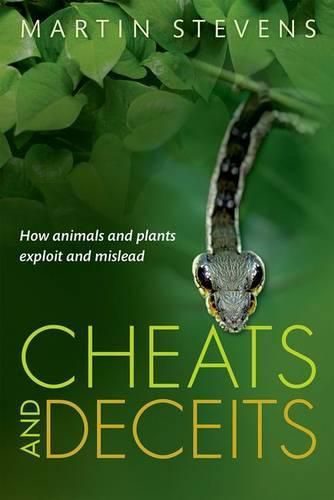Readings Newsletter
Become a Readings Member to make your shopping experience even easier.
Sign in or sign up for free!
You’re not far away from qualifying for FREE standard shipping within Australia
You’ve qualified for FREE standard shipping within Australia
The cart is loading…






In nature, trickery and deception are widespread. Animals and plants mimic other objects or species in the environment for protection, trick other species into rearing their young, lure prey to their death, and deceive potential mates for reproduction. Cuckoos lay eggs carefully matched to their host’s own clutch. Harmless butterflies mimic the wing patterning of a poisonous butterfly to avoid being eaten. The deep-sea angler fish hangs a glowing, fleshy lure in front of its mouth to draw the attention of potential prey, while some male fish alter their appearance to look like females in order to sneak past rivals in mating. Some orchids develop the smell of female insects in order to attract pollinators, while carnivorous plants lure insects to their death with colourful displays. In this book, Martin Stevens describes the remarkable range of such adaptations in nature, and considers how they have evolved, and become increasingly perfected as part of an arms race between predator and prey or host and parasite. He explores the work of naturalists and biologists from Alfred Russel Wallace to current research, showing how scientists find ways of testing the impact of particular behaviours and colourings on the animals it is meant to fool, as opposed to our human perceptions. Drawing on a wide range of examples, Stevens considers what deception tells us about the process of evolution and adaptation.
$9.00 standard shipping within Australia
FREE standard shipping within Australia for orders over $100.00
Express & International shipping calculated at checkout
In nature, trickery and deception are widespread. Animals and plants mimic other objects or species in the environment for protection, trick other species into rearing their young, lure prey to their death, and deceive potential mates for reproduction. Cuckoos lay eggs carefully matched to their host’s own clutch. Harmless butterflies mimic the wing patterning of a poisonous butterfly to avoid being eaten. The deep-sea angler fish hangs a glowing, fleshy lure in front of its mouth to draw the attention of potential prey, while some male fish alter their appearance to look like females in order to sneak past rivals in mating. Some orchids develop the smell of female insects in order to attract pollinators, while carnivorous plants lure insects to their death with colourful displays. In this book, Martin Stevens describes the remarkable range of such adaptations in nature, and considers how they have evolved, and become increasingly perfected as part of an arms race between predator and prey or host and parasite. He explores the work of naturalists and biologists from Alfred Russel Wallace to current research, showing how scientists find ways of testing the impact of particular behaviours and colourings on the animals it is meant to fool, as opposed to our human perceptions. Drawing on a wide range of examples, Stevens considers what deception tells us about the process of evolution and adaptation.